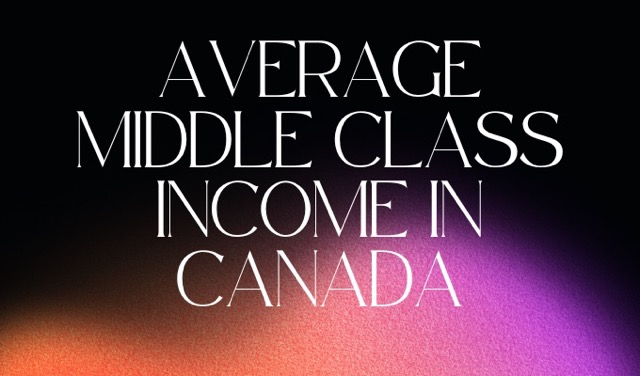The Average Middle Class Income Are you curious about what constitutes middle class income in Canada? Do you want to know how your income compares to others across the country? In this post, we will delve deep into the average middle class income in Canada. We will examine factors that affect middle class income, such as gender and age group distribution. We will also explore the impact of job industries on middle class income and how household expenditures can affect disposable income rates. Additionally, we will compare Canada’s middle class income to other countries to see where it stands on a global scale. So let’s take a closer look at what makes up this vital part of our society.
Outlines Of Guide
ToggleUnderstanding The Average Middle Class Income
A significant portion of Canadian families relies on middle class income, which plays a vital role in social development and economic growth. As per Statistics Canada, this income range encompasses a broad spectrum of household earnings and is essential for policymaking and income distribution. Notably, middle class income can vary based on the cost of living and household size, highlighting the need to account for regional disparities and family dynamics in defining this segment of society.
Canada is renowned for both its high standard of living and its extensive social welfare programs. By being aware of the average income in the country, we can obtain a better understanding of the financial circumstances of our fellow Canadians. In Canada, more than 15% of people earn at least 15% of their annual income through salary. The median income after taxes is $66,800, while the average income before taxes is nearly $70,000. Whether you plan to live in Canada or simply want to compare your income to the average, it is important to have an idea of what to expect. In this post we are going to discuss in detail about Average Middle Class Income in Canada, we will also provide province wise average income in Canada.
Province Wise Average Income
| Province | Average middle-Class Income (Household) 2023 | Average Income for a Single Person in 2023 |
| British Columbia | $67,500 | $66,232 |
| Alberta | $77,700 | $74,237 |
| Saskatchewan | $67,700 | $88,424 |
| Manitoba | $63,000 | $58,500 |
| Ontario | $70,100 | $63,369 |
| Quebec | $59,700 | $57,506 |
| Prince Edward Island | $59,400 | $46,160 |
| Nova Scotia | $57,500 | $56,550 |
| New Brunswick | $56,900 | $57,336 |
| Newfoundland and Labrador | $59,300 | $52,562 |
| Yukon | $86,300 | $62,500 |
| Nunavut | $118,000 | $74,900 |
| Northwest Territories | $127,000 | $77,900 |
We trust that this table will assist you in selecting the province where you desire to relocate, taking into consideration the minimum income provided by each province. It is evident from the data that certain provinces have considerably higher average annual incomes compared to others. Out of all the provinces, Nunavut boasts the highest average annual income, while the Northwest Territories lead in terms of median family income.
What Constitutes Middle Class?
To understand what constitutes the middle class, we need to consider factors such as household income, disposable income, and the cost of living. Middle-class individuals typically have income levels above the poverty line and fall within the national average income distribution. Family structure and geographic location can also impact middle-class income, along with employment status and social assistance programs.
Factors Affecting Middle Class Income
The survey of unattached individuals plays a role in influencing middle class income levels. Household income, family income, and total income are crucial determinants of middle class status. Factors such as the working class, minimum wage, and annual income also contribute significantly to middle class income. Additionally, indigenous people, income inequality, and income disparities impact middle class status. Furthermore, median household income, yearly income, and median total income play key roles in defining middle class income.
The Average Middle Class Income in Canada 2024 Highlights
| Article Title | The Average Middle Class Income in Canada |
| Country | Canada |
| National Average Pay | $57,600 |
| Highest Income Providing Province | Nunavut and Alberta |
Average Income Across Canadian Provinces
Diverse income levels across Canadian provinces reflect the economic landscape, revealing income disparities and inequality. This understanding aids in formulating targeted social policies to address regional differences in living standards. Variances in median income play a pivotal role in national income statistics, highlighting the need for informed decision-making based on income distribution. These provincial income variances are essential for effective socio-economic planning and improving the well-being of Canadian families.
Variances Between Provincial Incomes
The income statistics across provinces reveal distinct distribution patterns, impacting poverty rates and income survey results. Variations in median income levels offer insights into middle-class income disparities, highlighting differences in average household income. Additionally, unemployment rates, average earnings, and income levels vary, influencing the overall economic landscape. These disparities emphasize the diverse income levels across Canadian provinces, reflecting the complex social and economic dynamics within the country.
Provinces with Highest and Lowest Middle Class Incomes
Comparing regional middle class income levels unveils income disparities, with some provinces boasting upper middle class earnings, while others face income challenges. These variations expose the distribution of working-class and lower income groups across Canadian provinces, capturing income diversity nationwide. Statistics Canada’s income survey outlines the stark contrasts in average incomes, shedding light on the economic landscape and influencing targeted social policies.
Province Wise Income Considerations
Apart from the cost of living, there are various crucial factors that determine the average salary in each province. These include the types of available jobs and their corresponding average pay. Furthermore, the minimum salaries differ across provinces, which also influences the overall average income. It’s worth noting that certain areas within each province have significantly higher average earnings compared to others. This is an important aspect to consider as well. There could be several reasons for this disparity, such as these areas being mining towns or offering a unique specialization that other locations lack.
Analyzing the Gender Income Gap in Canada
Examining income disparities is crucial for achieving income equality and understanding the impact of the gender pay gap on median Canadian workers’ income. Income inequality statistics reflect gender income disparities within the working class and their effects on middle-class income distribution. Addressing the gender income gap is essential for balancing income distribution among Canadian families and reducing income disparities across the country.
Factors Contributing to the Gender Income Gap
Analyzing factors contributing to the gender income gap unveils income inequality aspects. Federal amounts, median income, and gender income disparities play a pivotal role. Upper class earnings exhibit significant gender income differences. The impact of the gender income gap is felt by the lower middle class and the working class population. Understanding these factors is crucial in addressing and rectifying gender income disparities.
Impact of the Gender Income Gap on Middle Class Income
Addressing income inequality can positively impact the median total income of Canadian families. The gender income gap statistics significantly influence middle class household annual income levels. Tackling these disparities is vital for fair income distribution within the middle class. Policies targeting income differences can benefit the middle class income distribution, contributing to social development in Canada. This effort aligns with the goals of organizations like Statistics Canada and social development programs like the pension plan.
Age Group Distribution of Middle Class Income
The distribution of middle class income across age groups reflects income mobility and aids in social policy planning. Income levels among different age groups impact middle class income distribution, helping identify income inequality trends. Analyzing age-based income survey results offers insights into middle class income disparities, shedding light on areas for intervention and improvement. Understanding the dynamics of middle class income by age is crucial for addressing income inequality and promoting economic balance.
Middle Class Income Among Millennials
Millennials are witnessing a shift in middle class income patterns, influenced by factors like education and debt. The cost of living plays a crucial role in determining the middle class income among millennials, impacting overall income distribution. Variations in middle class income exist across different provinces in Canada, reflecting the diverse socio-economic landscape. The changes in middle class income of millennials are significant for understanding the evolving dynamics of Canadian families.
Comparing Middle Class Income Across Different Age Groups
Comparing middle class income across different age groups unveils income distribution trends. Age significantly influences middle class income disparities, varying based on employment opportunities. The impact of inflation on middle class income differs across age groups, making it crucial for economic policies. Understanding these differences helps tailor social and economic policies accordingly. Utilizing data from Statistics Canada and Social Development Canada is essential for accurate analysis. Prince Edward Island, part of the middle class, is a key demographic to consider.
Examining High-Paying and Low-Paying Job Industries in Canada
The Canadian job market reflects diverse income distributions. High-paying industries like healthcare, technology, finance, construction, and engineering stand out, contrasting with low-paying sectors such as retail, food service, hospitality, and agriculture. Diverse factors like education, experience, location, and company size influence income levels, averaging around $70,000 annually. Regional cost of living variations impact income assessment, considering housing, transportation, and healthcare expenses.
Role of Job Industries in Determining Middle Class Income
The industry where an individual works significantly influences their middle class income in Canada. Sectors like finance, technology, and healthcare typically offer higher salaries for middle class positions. Blue collar industries such as manufacturing and construction also provide decent middle class incomes. Conversely, service sectors like retail and food service generally offer lower middle class incomes. Moreover, education level and experience play a crucial role in determining middle class income within each industry.
The Rise of High-Paying Industries and its Effect on Middle Class Income
The increasing average middle-class income in Canada is attributed to the growth of high-paying industries like technology and healthcare. Despite this, a significant income gap persists between top earners and the rest of the middle class. Implementing policies such as progressive taxation and investing in education can aid in reducing income inequality. The COVID-19 pandemic has accentuated the value of essential workers, potentially leading to higher salaries in certain industries. It is crucial for families to manage finances wisely for sustained financial stability.
Household Expenditures and Their Impact on Middle Class Income
Household expenditures play a crucial role in the average income of Canadian families. Understanding how these expenses impact middle class income is essential. According to Statistics Canada, housing, transportation, and healthcare are common expenses that significantly affect disposable income. To maintain a comfortable lifestyle, it’s important for the middle class to strategically plan their finances and find ways to reduce expenses. This financial planning can help ensure the social and economic well-being of Canadian families.
How Middle Class Canadians Allocate Their Income
Middle class Canadians allocate their earnings to cover essential needs like housing, food, and transportation while also prioritizing savings for retirement and emergencies. Additionally, they invest in education and professional development to enhance their earning potential. Disposable income is often directed towards leisure activities, travel, and hobbies. Effective budgeting and financial planning are essential for middle-class Canadians to achieve their financial objectives.
Reviewing Disposable Income Rates Across Canada
The disparity in the average middle-class income across Canada’s provinces and cities is significant. What matters most is a family’s disposable income, considering basic needs, cost of living, and taxes. Canadian families can benefit from government programs and tax credits to enhance their disposable income. It’s crucial to make astute financial decisions for maximizing disposable income. Statistics Canada data reveals varying disposable income rates, emphasizing the need for prudent financial planning
Importance of Disposable Income for the Middle Class
The economic growth and stability of Canadian families hinge on the disposable income of the middle class. Statistics Canada reveals that disposable income levels directly impact their standard of living, making it a key economic well-being indicator. Policies related to disposable income significantly influence the middle class lifestyle, calling for a strategic approach to improve financial security. This is pivotal for social development in Canada.
How does Middle Class Income in Canada compare to other countries?
Comparing middle class income in Canada to other countries provides valuable insights into global income distribution trends. It sheds light on economic differences and offers perspectives on income inequality on a global scale. Understanding how Canada’s middle class income compares to other nations reflects economic development disparities.
Conclusion
According to income figures, specialist physicians earned the highest average salary of $303,400 in Canada in 2020. The various provinces and territory of Canada had slightly different sectors that offered the highest pay. As of April 1, 2023, the federal minimum wage in Canada has increased to $16.65 per hour. A news release from Employment and Social Development Canada states that approximately 26,000 Canadian workers who currently earn less than this wage will benefit from this raise, as it will make their cost of living more manageable. Each province has its own minimum wage requirements. If the salary in a territory or province is below the federal amount, the employer must make up the difference. Furthermore, New Brunswick, PEI, and Quebec are considered to be the most affordable provinces to live in Canada.











































